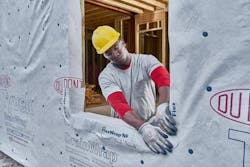After decades of trying to tighten the building envelope, housewrap and weather barrier manufacturers are looking to let in some breeze to dry out the moisture. See 9 great options from our sister magazine, PRODUCTS.
Lucas Hamilton, for one, thinks it is time for housewrap makers to loosen up a little bit. A research and development and applied building science manager for CertainTeed, the former construction litigation specialist says change is coming to the residential building envelope. After decades of trying to get water and air barriers ever-tighter, he and fellow R&D experts are beginning to see greater value in products that can air out the wall cavity by promoting ventilation in addition to moisture permeability.
“Ventilation is huge, and everyone needs to get back on the bandwagon,” says Hamilton. “We are really waking up to the fact that having drained and ventilated claddings is a tremendous boon to wall system durability. Especially as we add more layers of control and insulation and weather barriers, we have to find a way to put drying potential back into these assemblies, and that means another look at some of the properties on water barrier products.”
To that end, Hamilton regularly runs predictive modelling scenarios through WUFI, the German-made thermodynamic software that has become an industry standard for heat and moisture transfer analysis. Since house cladding is prone to weather intrusion (i.e. wind-driven rain and snow), present day housewrap technology has developed to minimize (or even eliminate) moisture and air transfer for greater energy efficiency.
See 9 housewraps that block air but allow water vapor to escape at PRODUCTS online
